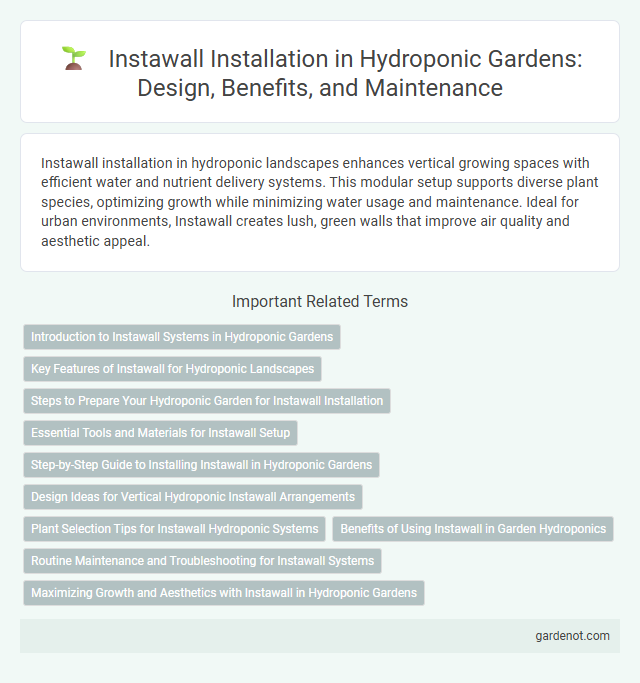Instawall installation in hydroponic landscapes enhances vertical growing spaces with efficient water and nutrient delivery systems. This modular setup supports diverse plant species, optimizing growth while minimizing water usage and maintenance. Ideal for urban environments, Instawall creates lush, green walls that improve air quality and aesthetic appeal.
Introduction to Instawall Systems in Hydroponic Gardens
Instawall Systems provide modular, vertical hydroponic installations designed for efficient space utilization and enhanced plant growth. These systems integrate advanced nutrient delivery and aeroponic technologies to optimize water and nutrient absorption, supporting diverse plant species in urban and commercial hydroponic gardens. Instawall's scalable design and durable materials ensure sustainable, low-maintenance green walls suitable for both indoor and outdoor hydroponic applications.
Key Features of Instawall for Hydroponic Landscapes
Instawall for hydroponic landscapes offers modular panels designed for easy vertical garden installation, providing efficient water circulation systems that optimize nutrient delivery to plants. Its lightweight, durable materials support robust root growth while ensuring structural stability in various environments. Integrated irrigation channels and customizable layouts enhance space utilization, promoting healthy plant development and sustainable urban greening.
Steps to Prepare Your Hydroponic Garden for Instawall Installation
Preparing your hydroponic garden for Instawall installation begins with assessing the available wall space and ensuring adequate structural support to hold the system securely. Clean the wall surface and install a waterproof backing to protect against moisture damage and facilitate easy maintenance. Finally, plan your plant arrangement and nutrient flow system to optimize the vertical growing environment and maximize plant health in the Instawall setup.
Essential Tools and Materials for Instawall Setup
Essential tools for Instawall installation in hydroponic landscapes include a cordless drill, level, measuring tape, and a stud finder to ensure precise mounting and alignment. Materials such as waterproof backing boards, high-quality mounting brackets, and durable irrigation tubing are critical for structural stability and efficient water delivery. Utilizing pH-balanced nutrient solutions and waterproof LED grow lights enhances plant growth while maintaining system longevity.
Step-by-Step Guide to Installing Instawall in Hydroponic Gardens
Start by securely mounting the Instawall frame on a vertical surface that receives adequate natural or artificial light. Attach the hydroponic nutrient reservoir and connect the irrigation tubing to ensure nutrient solution reaches all planting pockets evenly. Insert plants into the modular slots, then monitor water flow and nutrient levels regularly to maintain optimal growth conditions.
Design Ideas for Vertical Hydroponic Instawall Arrangements
Vertical hydroponic Instawall arrangements maximize space efficiency by integrating modular panels that support diverse plant species, enhancing urban green environments. Incorporating geometric patterns and varying plant textures creates visually dynamic walls that improve air quality and aesthetic appeal. Optimized water circulation systems within the Instawall sustain plant health while reducing maintenance requirements in sustainable indoor and outdoor landscapes.
Plant Selection Tips for Instawall Hydroponic Systems
Choose plants with shallow root systems and high adaptability to hydroponic environments for optimal Instawall installation results. Prioritize leafy greens, herbs, and small flowering plants that thrive in controlled moisture and nutrient delivery. Ensure plants have similar light and water requirements to maintain uniform growth and reduce maintenance challenges.
Benefits of Using Instawall in Garden Hydroponics
Instawall installation in garden hydroponics enhances plant growth by providing a modular, vertical growing surface that maximizes space efficiency and improves nutrient delivery. Its lightweight, durable structure enables easy setup and maintenance while promoting optimal water circulation and root aeration. Using Instawall reduces soil contamination risks and supports sustainable gardening practices through reduced water usage and chemical inputs.
Routine Maintenance and Troubleshooting for Instawall Systems
Routine maintenance for Instawall hydroponic systems involves regularly inspecting water pumps, nutrient delivery lines, and filtration units to ensure optimal performance and prevent clogging. Troubleshooting common issues such as uneven plant growth or pump failures requires checking system sensors, adjusting nutrient concentrations, and cleaning biofilm buildup from irrigation components. Consistent monitoring and timely intervention enhance the longevity and efficiency of Instawall vertical gardens, promoting robust hydroponic landscape health.
Maximizing Growth and Aesthetics with Instawall in Hydroponic Gardens
Instawall installation in hydroponic gardens significantly enhances plant growth by providing a modular, vertical structure that optimizes space and nutrient delivery. The system's innovative design promotes uniform water distribution and aeration, resulting in healthier roots and accelerated growth cycles. Its sleek, customizable panels also elevate garden aesthetics while supporting a diverse range of crops in limited spaces.
Instawall installation Infographic

 gardenot.com
gardenot.com